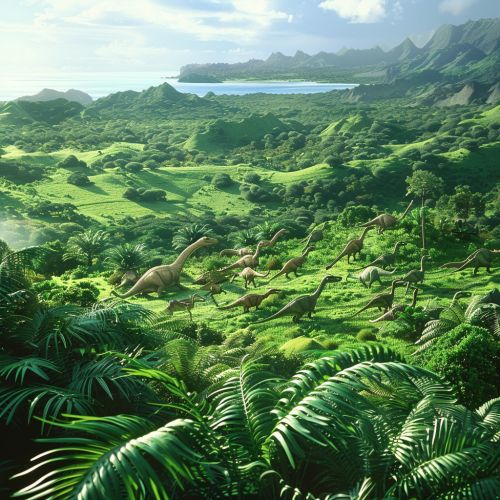Cretaceous Period
Geological Time Frame
The Cretaceous Period is the third and final epoch of the Mesozoic Era, following the Jurassic Period and preceding the Paleogene Period. It spans from approximately 145 to 66 million years ago, a duration of about 79 million years. The Cretaceous Period is further divided into the Early and Late Cretaceous epochs.
Climate
The Cretaceous climate was warmer than today's, with little to no polar ice and high eustatic sea levels. The greenhouse effect was likely more pronounced due to high levels of carbon dioxide in the atmosphere. The warm climate extended into the polar regions, with evidence of high-latitude forests and dinosaurs in areas now considered too cold for such ecosystems.
Flora
The Cretaceous Period saw significant changes in plant life. The early Cretaceous was dominated by gymnosperms, but by the end of the period, angiosperms (flowering plants) had become the dominant form of plant life. This shift had a profound impact on the world's ecosystems, as flowering plants provide a more diverse array of food sources for herbivores.
Fauna
The Cretaceous Period is perhaps best known for its dinosaur fauna. Iconic genera such as Tyrannosaurus, Triceratops, and Velociraptor lived during this time. In addition to dinosaurs, the Cretaceous saw a diversification of other reptiles, including the first snakes and the evolution of crocodilians into more modern forms. The period also saw the evolution of the first true birds, such as Archaeopteryx.
Marine Life
The Cretaceous seas were home to a diverse array of marine life. The period saw the rise of modern shark families, the appearance of the first true crabs, and the diversification of bony fish. The Cretaceous also saw the evolution of the first modern corals, which formed extensive reef systems. The period is perhaps best known for its marine reptiles, including ichthyosaurs, plesiosaurs, and mosasaurs.
Mass Extinction
The end of the Cretaceous Period is marked by one of the most significant mass extinctions in Earth's history, known as the Cretaceous–Paleogene (K–Pg) extinction event. This event, which occurred approximately 66 million years ago, resulted in the extinction of approximately 75% of all species on Earth, most notably the non-avian dinosaurs.
See Also


